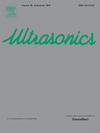Evaluation of osteoporosis features in cortical bone models using pattern recognition methods applied to ultrasound data
IF 4.1
2区 物理与天体物理
Q1 ACOUSTICS
引用次数: 0
Abstract
Cortical bone plays a crucial role in bone strength in the context of osteoporosis. Thinning of the cortex and intracortical porosity developing from the endosteum are the main independent indicators of osteoporosis-related fractures risk, which can be separately quantified by advanced imaging techniques. Numerous studies have shown the sensitivity of ultrasonic guided waves to changes in the thickness and porosity of cortical bone both in models and in human subjects. The present study demonstrates feasibility of the pattern recognition approach to separate determination of factors of diagnostic interest – cortical thickness (CTh) and intracortical porosity as the relative thickness of the porous layer (rPTh), where a set of guided waves velocities at different frequencies are used as evaluation criteria. The experiments were carried out on acrylic plastic plates as compact bone phantoms of different thicknesses with simulated pores in the form of CNC-drilled holes from below. The distance-time slopes of fast and slow wave packets at 250, 100 and 50 kHz were obtained as distance-time slopes in the corresponding spatiotemporal waveform profiles built by stepwise acquisition of ultrasonic signals. The evaluation criteria (distance-time slopes) in the training dataset formed the decision rules – 3-dimensional surfaces of the criterion distribution in the field CTh-rPTh. For the test object, the intersection of the segments of the probabilistic solution according to three decision rules gave the evaluation answer. The method allowed us to determine the values of both factors CTh and rPTh with reasonable diagnostic accuracy at different thicknesses of the covering soft tissues. The proposed approach can be adapted for the assessment of osteoporosis after obtaining an appropriate database in human studies.
应用超声数据的模式识别方法评估皮质骨模型中的骨质疏松症特征。
在骨质疏松的情况下,皮质骨在骨强度中起着至关重要的作用。皮质变薄和皮层内骨质疏松是骨质疏松相关骨折风险的主要独立指标,可以通过先进的成像技术分别量化。大量研究表明超声引导波对模型和人类受试者皮质骨厚度和孔隙度变化的敏感性。本研究证明了模式识别方法的可行性,将诊断感兴趣的因素-皮质厚度(CTh)和皮质内孔隙度作为多孔层的相对厚度(rPTh),其中使用不同频率的一组导波速度作为评估标准。实验在亚克力塑料板上进行,作为不同厚度的致密骨模型,并以cnc从下面钻孔的形式模拟孔隙。通过逐级采集超声信号,得到250、100和50 kHz时快慢波包的距离-时间斜率作为相应时空波形曲线的距离-时间斜率。训练数据集中的评价准则(距离-时间斜率)形成了CTh-rPTh场中准则分布的决策规则-三维曲面。对于测试对象,根据三种决策规则的概率解分段的交点给出评价答案。该方法使我们能够确定因子CTh和rPTh的值,在不同的覆盖软组织厚度下具有合理的诊断准确性。在人类研究中获得适当的数据库后,提出的方法可用于骨质疏松症的评估。
本文章由计算机程序翻译,如有差异,请以英文原文为准。
求助全文
约1分钟内获得全文
求助全文
来源期刊

Ultrasonics
医学-核医学
CiteScore
7.60
自引率
19.00%
发文量
186
审稿时长
3.9 months
期刊介绍:
Ultrasonics is the only internationally established journal which covers the entire field of ultrasound research and technology and all its many applications. Ultrasonics contains a variety of sections to keep readers fully informed and up-to-date on the whole spectrum of research and development throughout the world. Ultrasonics publishes papers of exceptional quality and of relevance to both academia and industry. Manuscripts in which ultrasonics is a central issue and not simply an incidental tool or minor issue, are welcomed.
As well as top quality original research papers and review articles by world renowned experts, Ultrasonics also regularly features short communications, a calendar of forthcoming events and special issues dedicated to topical subjects.
 求助内容:
求助内容: 应助结果提醒方式:
应助结果提醒方式:


